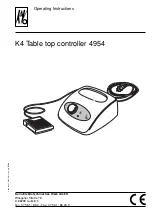
Waveform Setup
R&S
®
RTM3000
70
User Manual 1335.9090.02 ─ 08
Remote command:
Acquire Mode
Defines how the waveform is built from the captured samples. There are two general
methods to build the waveform record: sample decimation and waveform arithmetic.
Sample decimation reduces the data stream of the ADC to a stream of waveform
points with lower sample rate and a less precise time resolution. The R&S
RTM3000
uses decimation, if the waveform sample rate is less than the ADC sample rate. The
acquisition modes "Peak Detect" and "High Resolution" are decimation methods.
Waveform arithmetic builds the resulting waveform from several consecutive acquisi-
tions of the signal. The acquisition modes "Average" and "Envelope" are arithmetic
methods.
"Sample"
Usually, most signals are displayed optimally with this acquisition
mode but very short glitches might remain undiscovered by this
method.
If the sample rate of the waveform is less than the ADC sample rate,
the instrument reduces the number of samples: one of n samples in a
sample interval is recorded as waveform point, the other samples are
discarded (decimation). Conversely, if the sample rate of the wave-
form is higher than the ADC sample rate, the instrument adds wave-
form points to the captured samples using an interpolation method.
"Peak Detect"
The minimum and the maximum of n samples are recorded as wave-
form points, the other samples are discarded. Thus the instrument
can detect fast signal peaks at slow time scale settings that would be
missed with other acquisition modes.
"High Resolu-
tion"
The average of n captured sample points is recorded as one wave-
form sample. Averaging reduces the noise, the result is a more pre-
cise waveform with higher vertical resolution.
"Average"
The average is calculated from the data of the current acquisition and
a number of consecutive acquisitions before. The method reduces
random noise. It requires a stable, triggered and repetitive signal.
The number of acquisitions for average calculation is defined with
"A
HR"
Combines the high resolution mode with averaging over several
acquisitions.
"Envelope"
Each acquisition is done in sample mode, and the minimum and max-
imum values over some consecutive acquisitions build the envelope.
The resulting diagram shows two envelope waveforms below and
above the normal waveform: the minimums (floor) and maximums
(roof), representing the borders in which the signal occurs. this
method is useful, for example, if the waveform is noisy but the noise
is not relevant for the measurement.
"Enve-
lope
+
PD"
Each acquisition is done in peak detect mode, and the most extreme
values of all consecutive acquisitions build the envelope. This method
is more precise than "Envelope".
Acquisition Setup
www.allice.de
Allice Messtechnik GmbH
















































